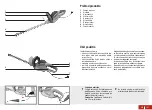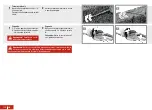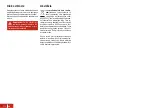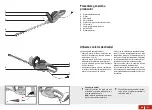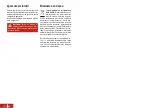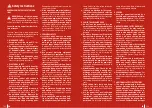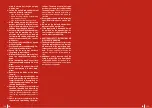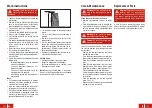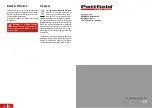
EN
132
EN
133
Safety Instructions
GENERAL POWER TOOL SAFETY WARN-
INGS
WARNING Read all safety warnings
and all instructions.
Failure to follow
the warnings and instructions may re-
sult in electric shock, fire and/or serious injury.
Save all warnings and instructions for fu-
ture reference.
The term "power tool" in the warnings refers
to your mains-operated (corded) power tool or
battery-operated (cordless) power tool.
1 WORK AREA SAFETY
a)
Keep work area clean and well lit.
Clut-
tered or dark areas invite accidents.
b)
Do not operate power tools in explosive
atmospheres, such as in the presence
of flammable liquids, gases or dust.
Power tools create sparks which may ignite
the dust or fumes.
c)
Keep children and bystanders away
while operating a power tool.
Distrac-
tions can cause you to lose control.
2 ELECTRICAL SAFETY
a)
Power tool plugs must match the outlet.
Never modify the plug in any way. Do
not use any adapter plugs with earthed
(grounded) power tools.
Unmodified
plugs and matching outlets will reduce risk
of electric shock.
b)
Avoid body contact with earthed or
grounded surfaces, such as pipes, ra-
diators, ranges and refrigerators.
There
is an increased risk of electric shock if your
body is earthed or grounded.
c)
Do not expose power tools to rain or wet
conditions.
Water entering a power tool
will increase the risk of electric shock.
d)
Do not abuse the cord. Never use the
cord for carrying, pulling or unplugging
the power tool. Keep cord away from
heat, oil, sharp edges or moving parts.
Damaged or entangled cords increase the
risk of electric shock.
e)
When operating a power tool outdoors,
use an extension cord suitable for out-
door use.
Use of a cord suitable for out-
door use reduces the risk of electric shock.
f)
If operating a power tool in a damp lo-
cation is unavoidable, use a residual
current device (RCD) protected supply.
It is recommended to use a Residual Cur-
rent Device (RCD) with a tripping current
of not more than 30 mA.
Use of an RCD
reduces the risk of electric shock.
3 PERSONAL SAFETY
a)
Stay alert, watch what you are doing
and use common sense when operating
a power tool. Do not use a power tool
while you are tired or under the influ-
ence of drugs, alcohol or medication.
A moment of inattention while operating
power tools may result in serious personal
injury.
b)
Use personal protective equipment.
Always wear eye protection.
Protective
equipment such as dust mask, non-skid
safety shoes, hard hat, or hearing protec-
tion used for appropriate conditions will
reduce personal injuries.
c)
Prevent unintentional starting. Ensure
the switch is in the off-position before
connecting to power source and/or bat-
tery pack, picking up or carrying the
tool.
Carrying power tools with your finger
on the switch or energising power tools
that have the switch on invites accidents.
d)
Remove any adjusting key or wrench
before turning the power tool on.
A
wrench or a key left attached to a rotating
part of the power tool may result in per-
sonal injury.
e)
Do not overreach. Keep proper footing
and balance at all times.
This enables
better control of the power tool in unex-
pected situations.
f)
Dress properly. Do not wear loose cloth-
ing or jewellery. Keep your hair, cloth-
ing and gloves away from moving parts.
Loose clothes, jewellery or long hair can be
caught in moving parts.
g)
If devices are provided for the connec-
tion of dust extraction and collection
facilities, ensure these are connected
and properly used.
Use of dust collection
can reduce dust-related hazards.
4 POWER TOOL USE AND CARE
a)
Do not force the power tool. Use the
correct power tool for your application.
The correct power tool will do the job bet-
ter and safer at the rate for which it was
designed.
b)
Do not use the power tool if the switch
does not turn it on and off.
Any power
tool that cannot be controlled with the
switch is dangerous and must be repaired.
c)
Disconnect the plug from the power
source and/or the battery pack from the
power tool before making any adjust-
ments, changing accessories, or stor-
ing power tools.
Such preventive safety
measures reduce the risk of starting the
power tool accidentally.
d)
Store idle power tools out of the reach
of children and do not allow persons
unfamiliar with the power tool or these
instructions to operate the power tool.
Power tools are dangerous in the hands of
untrained users.
e)
Maintain power tools. Check for mis-
alignment or binding of moving parts,
breakage of parts and any other con-
dition that may affect the power tool’s
operation. If damaged, have the power
tool repaired before use.
Many accidents
are caused by poorly maintained power
tools.
f)
Keep cutting tools sharp and clean.
Properly maintained cutting tools with
sharp cutting edges are less likely to bind
and are easier to control.
g)
Use the power tool, accessories and
tool bits etc. in accordance with these
instructions, taking into account the
working conditions and the work to be
performed.
Use of the power tool for oper-
ations different from those intended could
result in a hazardous situation.
5 SERVICE
a)
Have your power tool serviced by a
qualified repair person using only iden-
tical replacement parts.
This will ensure
that the safety of the power tool is main-
tained.
6 HEDGE TRIMMER SAFETY WARNINGS
a)
Keep all parts of the body away from
the cutter blade. Do not remove cut ma-
terial or hold material to be cut when
blades are moving. Make sure the
switch is off when clearing jammed
material.
A moment of inattention while
operating the hedge trimmer may result in
serious personal injury.
b)
Carry the hedge trimmer by the handle
with the cutter blade stopped. When
transporting or storing the hedge trim-
mer always fit the cutting device cover.
Proper handling of the hedge trimmer will
reduce possible personal injury from the
cutter blades.
c)
Hold the power tool by insulated grip-
ping surfaces only, because the cutter
blade may contact hidden wiring or
its own cord.
Cutter blades contacting a
"live" wire may make exposed metal parts
of the power tool "live" and could give the
operator an electric shock.
d)
Keep cable away from cutting area.
Dur-
ing operation the cable may be hidden in
shrubs and can be accidentally cut by the
blade.
7 ADDITIONAL SAFETY INSTRUCTIONS
a)
This unit is not designed to be used by
persons (including children) who have
limited physical, sensory or mental
abilities or who have inadequate ex-
perience and/or knowledge of the unit,
unless they are supervised by a person
responsible for their safety or they have
been instructed by the person how to
use the unit. Children should be super-


